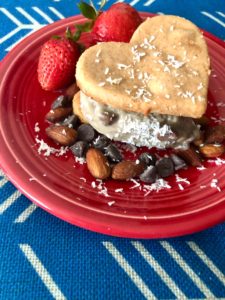Microgreens have been around longer than our modern culture. 🌱
It was a way of food survival during the winter months of the oldest civilizations on our planet… a lot like how modern squirrels have preserved the foraging acorn traditions.

Which btw… is outdoor entertaining to watch Rocky the flying squirrel in his purposeful scurrying meal prep moves. 🐿️
How they actually feel about their work we’ll never know, but it has kept their species around.
…And to keep ours going, modern food planning is something we do.
In human life, that’s how it can look with us daily running around in our busy lives… and for me, that’s how it sometimes looked behind-the-scenes as a food service professional in organized chaos prepping and planning weekly catered event challenges in hotel ballrooms and for restaurant parties celebrating Mediterranean food styles.
And even with all the variety of food available to our planet we can be bored with our food sourcing options. 🥬
Daily, we open the fridge and pantry cupboards thinking: “what’s for dinner?” or “what can I have for a little snack?”…sometimes coming up short for a good answer. 🤔
Microgreens can be part of the answer as a healthy and tasty choice.
Here are 5 points that make microgreens a smart choice:
Point #1: Microgreens are food like-able and tasty good.
…Because if they weren’t, why bother?
Children seem to love them as some of the pickiest green eaters on earth.
Many microgreens are smaller, cute kid-size bits and bites like baby arugula, so it’s easier to get a handful of the finger foods than the adult version.
The young greens also add interest, taste, and texture to any plate.
…And why they’re not more commonly known today is unknown. Maybe like their shape-forms, they still have a wild-like reputation… 🌿
Like, I remember alfalfa sprout microgreens from a school age where I once saw the jungle wild-looking tangly-fine weeds in a friend’s lunch box that made me curious…
And now as an adult, thinking it’s a good idea. 🎉
You grow into new perspectives and healthy ways and today is a great way to spruce up 😋 and vertically beef up a light protein mustardy salad sandwich or the like (…einkorn finger sandwich idea below 🧡). Or to garnish a bowl of beets…
Point # 2: Microgreens are less bitter.
Microgreens have the reputation of being less bitter that is good news for some people’s tongues who avoid the taste.
That reminds me of green tea…
If you don’t love bitter green tea tastes that can grow stronger if brewed too hot or you picked the wrong flavor for you, then you probably don’t lean toward preferring many bitter tasting superfood veggies and plant greens.
And that’s why certain veggies 🥦🥬 don’t end up on the plate (like green tea in cups)… or in a diet despite their healthy goodness.
…Green teas 🍵 come from the same Camellia Sinensis plant as common black, white, and oolong teas but differ in process where they’re not oxidized like common black teas.
And what makes the difference for microgreens (and similar to green teas) is the process from the same plant.
Microgreens are harvested early, coming from the same plants as the adult version we see mostly on shelf space in grocery stores. 🌱
So they’re fresh and have different tastes worth trying, often more mild tasting and welcoming to all.
Point #3: Young greens are replenishable, sustainable, and abundant.
…Just like other foods from the soil, nature provides and delivers over and over again..
When we think “fresh” we immediately think of the produce aisle in a supermarket, farmers market, or our backyard garden that produces fastly perishable foods that the soil can replenish.
If you’re a green thumb growing your own mini-market, you can have microgreens planted, harvested, and eatable within foreseeable weeks (and not months or seasons that is the time most produce take). 🧑🌾
That makes microgreens more productive… and where you can have more than what you know what to do with! A good problem to have. ✔️
That would be too easy for getting a meal on the table.
And that ideal IS microgreens.
When you choose the micro-world of microgreens, you too help our community and local farmers.
…Those are baby plant little steps that you can take for your health and to support the world. 🪴
Point #4 – Microgreens are often organic without pesticides.
So much of our plant-based foods are exterior sprayed with pesticides to deter mostly bugs, and that offsets the healthy goodness of the healthiest skin parts of the food.
We throw away the skin that could have been healthy edible parts.
And today, reusable composting ways are not yet available for the common household.
So then we end up creating more waste that adds more plastic bag waste that also attracts unwanted critter nuisances to our community. But what if composting machines were as common as house dishwashing machines? 💭
But that not being today’s standards, with organic microgreens we can eat those problems away as the end consumer. And our bodies are healthier for our choice.
Point #5 – Microgreens are low calories and high in nutrition.
There are few (if any) green plant-based foods 🌱 that aren’t low in calories compared to plant-based (as in factory) foods. 🏭
Fresh microgreens from nature come packed with vitamins and minerals, along with some eat-from-the-rainbow 🌈 polyphenols that make you excited to color your plate and palette with anti-inflammatory food ideas! 🎨
And, mighty microgreens can have 4x (and up to 40x!) more nutrients than their full-grown version.
🎯 Final Points:
Microgreens fit in our consumer micro cultures where we are becoming more customizable specific in food diet preferences that impact food growing ways, and where our farming culture impacts our world.
Sustainable food and young microgreens are sprouting interest in our fast climate changing world searching for longevity answers where eating anti-inflammatory foods fit.
One way you can be part of the anti-inflammatory solution is by growing your own portable microgreen micro garden that can be indoors (good for those with outdoor allergies or without garden space).
Plus, so many viable options to bring in more microgreens from dream to life… yasss!
…That’s something to be excited about today. If this resonates with you, could you PLEASE HELP share this message with others so they can join the MICROGREEN movement that’s healthy here to stay.🎉
Go micro GREEN 🌱
Oh, and heres’s an easy whole wheat or einkorn (ancient wheat) sandwich in a modern recipe you can use to make finger sandwiches that was an idea I grew up with in the catering party world… and you can use for lunch, brunch, or an afternoon party.
To gain smiles, simply add delicious microgreens like baby lettuce, cucumber, radishes, carrot, and tarragon.
And for dessert 🍥, some sweet herbs and spices are microgreens like anise that you can add to a creme anglaise for pancakes or sweet brunch waffles.
Einkorn Sandwiches with Microgreens
Ingredients
- einkorn flour, salt, and water for the sandwich bread.
- cottage cheese
- cucumber
- scallions
- carrots
- beets or radishes
- lettuce
- asparagus or favorite veggies
- spices: dill, tarragon, black pepper
Instructions
- Prepare the sandwich bread. You can make the bread in advance. Let dough proof: develop air pockets and double in size for for at least 2 hours. Then bake dough in oven in a small sheet pan about 1/4" thick until toasted. Tip: Einkorn wheat flour is not a high gluten (rise) flour, so it won't rise much and will lay more like a flat bread when baked. You need not knead long and can omit yeast. Let bread cool and slice the toast with a serated or bread knife.Alternatively if you use regular whole wheat flour, knead a few minutes longer and add about 1/4 tsp of instant yeast (easiest) for a bread that rises. You can cut horizontally into the vertical bread about 3-4 slices to get a similar flat bread effect. Optional: You can turn this into paninis by grilling or baking on a grill pan.
- Prepare the raw veggies. Thinly slice into flat or close to flat pieces.
- For the sandwich paste, mix cottage cheese, dill, tarragon, and black pepper. You can processor blend the cottage cheese if you would like a smoother paste.
- Add paste to the bottom of the sandwich and then layer lettuce, cucumbers, carrots, and others veggies. Add the sandwich bread top. For catering-style zhugh, you can add a toothpicked cucumber slice, or radish and beet and then plate. These easy, new old-fashioned touches show you put in extra detailed care.








